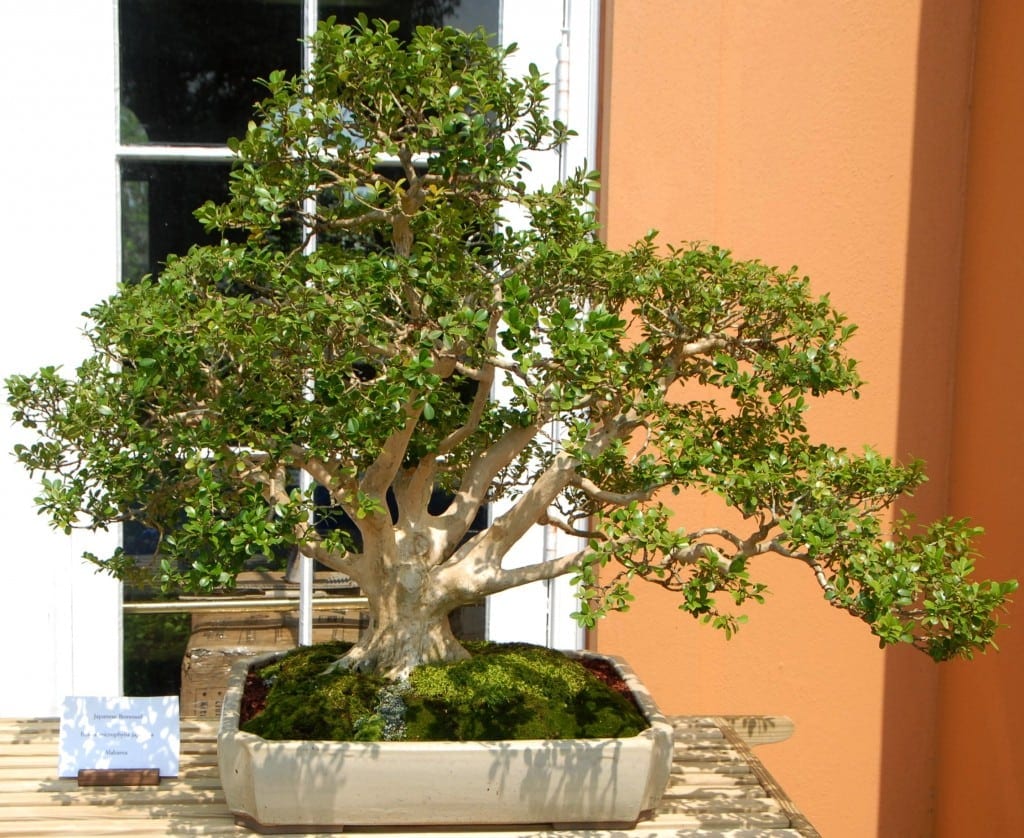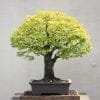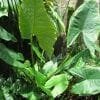Introduction
Boxwood is a very hardy plant and grows rapidly as well. These great characteristics make it a good tree to use as bonsai. Boxwood has more than 70 species and the common boxwood is the most popular. This is highly used as an ornamental plant and is grown and shaped into a variety of designs.
In England, boxwood trees are used in landscaping. Its pom-pom like appearance has earned it a good reputation among gardeners, landscaped artists and bonsai growers.
There are two common species of boxwood: Japanese boxwood (Buxus microphylla) and common boxwood (Buxus sempervirens). Learning how a boxwood grows and how it is cultivated and trained can help you grow boxwood bonsai trees like a pro.
| Scientific/Botanical Name | Buxus sempervirens |
| Description | There are more than 70 species of boxwood. The common boxwood is hardy and gains height rapidly. It works best for bonsai shaping. The root system is shallow, and the bark is thin. |
| Position | A semi-shady position is the best growing site. In its natural environment the plant occupies a position under tree canopies. Excessive sunlight can burn the leaves of the plant. The boxwood bonsai is not tolerant of temperatures below minus 4oCentigrade. |
| Watering | Water the plant as needed to keep the soil moist but not soggy. Reduce watering dramatically during the fall and winter. |
| Feeding | Feed boxwood bonsai with a bonsai fertilizer during the growing season. |
| Leaf and Branch Pruning | Regular thinning and pruning of the internal branches will encourage back-budding and the retention of leaves. The thinning of leaves will cause growth of shoots, which can then be trained into the desired shape. Common boxwood tolerates hard pruning exceptionally well. |
| Re-potting & Growing Medium | The plant should not be re-potted any sooner than two years, and three years may be optimal. If re-potted sooner, its growth will be extremely vigorous. |
| Wiring | Shape with wire while the buds are still soft, and the plant is pliable. Monitor the plant so as to prevent damage to the new bark that develops. |
| Notes | The boxwood plants found at nurseries and garden centers can be readily trained as bonsai specimens. |
What It Looks Like
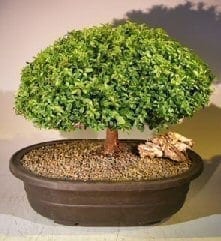
For anyone who has ever seen photos of English landscaping, Boxwood will be a familiar plant. Known for its pom-pom like design and ability to be shaped into living statues, Boxwood is actually a plant that is well-suited to be made into bonsai trees. The two most popular species of Boxwood are Buxus microphylla (Japanese Boxwood) and Buxus sempervirens (Common Boxwood).
For a more vigorous, fast growing plant, Common Boxwood is an ideal choice. Japanese Boxwood tends to grow slowly and is not as hearty. Both options have naturally short internodes and shallow root systems. These plants can withstand a great deal of pruning and have leaves that reduce well.
The bark on these species has a much older appearance than the plant deserves and can easily accumulate dirt. If it does accumulate dirt, the bark can be gently cleaned with just water and a toothbrush. Since the bark is very thin, it must be treated carefully to prevent any damage.
Growth Patterns
Boxwood grows very quickly, but it does not thicken very fast. Gardening books state that even in the wild, full-grown Boxwood may only grow to 3 inches wide after even 20 years of growth. To get around this, bonsai enthusiasts will often use older stock to start their bonsai. Boxwood hedges in the garden provide great material for new bonsai plants. All of the collecting should be done in March or April for the best results.
Other gardeners report success using air layering to start out their plants. For these cuttings, individuals should try to take them either in early spring or in fall. Each cutting needs to be at least four inches in length for it to successfully grow.
What you need to follow this tutorial
- A boxwood bonsai tree
- You can start creating bonsai out of an already alive boxwood bonsai tree. You can purchase a variety of boxwood trees online or from a local nursery because this is a very popular as well as a very common tree.
- Boxwood bonsai seeds
- You can also grow boxwood trees with the use of seeds. There are online shops and local seed banks that can sell seeds. You may also use the seeds from boxwood trees that are growing in your backyard or neighborhood.
- Bonsai Pot
- There are a variety of pots that you can use but be sure to choose a planter that has adequate drainage holes at the sides or at the bottom.
- Balanced fertilizer
- Boxwood trees need a regular dose of balanced fertilizer. You can purchase fertilizer specially made for bonsai from local garden shops or bonsai nurseries.
- Sharp scissors
- You need a sharp pair of scissors to prune boxwood bonsai trees. You also need a pair to prune the roots of bonsai if necessary.
- Pliers
- You need a pair of pliers to cut wires depending on how much you need You also need a good pair of sharp pliers to remove wires after you are done training your tree.
- Wire for wiring
- Boxwood trees require moderate to the strong wire as well as a wire that may be easily wrapped around the branch. Aluminum wires will work great for this type of tree. On the other hand, thick and hard branches need stronger wire like annealed copper wires.
- Clean water
- Boxwood trees need to be watered regularly. You may use tap water or rainwater on your bonsai but make sure that these are clean and do not contain toxic chemicals which can affect the health of your plants. Have your water tested when in doubt.
- Aggregates
- Use aggregates when potting and re-potting to improve soil drainage and aerating properties of your soil. There are a variety of aggregates that you can use on boxwood bonsai trees. You can use Akadama, decomposed granite, diatomite, pumic, sand with coarse grains and turface.
- Growing soil for bonsai
- Boxwood trees are very hardy trees and it needs soil that can offer better water and nutrient absorption as well as drainage. A sandy loam soil is the best and this is available in most garden shops or bonsai supplies shops and nurseries.
Step by step instructions
1) Understand fast facts about Boxwood bonsai trees
Boxwood trees are part of English landscaping because of its pom-pom design and its versatile leaves, stems, and trunks. It can be shaped into living statues and make great bonsai as well. Bonsai grows very quickly but despite this, it does not become thick and unruly in just a short amount of time. Even when grown in the wild, boxwood may grow rapidly but still maintains a short and manageable stature. If you have boxwood in your garden or neighborhood then you might want to use this to practice pruning, wiring or manipulating boxwood trees.
Description
Boxwood trees have more than 70 species. Understanding the type of boxwood you are trying to grow will be able to help you grow this bonsai well. The most common boxwood is the common boxwood which is a hardy tree that gains more height rapidly. This tree has a shallow root system and has a thin bark.
Common boxwood is a fast-growing tree while Japanese Boxwood grows slowly and is not as hearty. Both trees have naturally short internodes and shallow root system. Both plants can withstand a lot of pruning with leaves that reduce well. The bark of a boxwood tree looks older than its actual age, this can easily accumulate dirt so clean this regularly with a toothbrush. Treat the trunk, leaves, and stems of boxwood trees with care because these are very delicate.
Growing position
- Boxwood trees need a semi-shady position to grow.
- Naturally, this tree is found underneath canopies in forests.
- Do not expose this to excessive sunlight because this can burn the tree’s leaves.
- The boxwood can tolerate temperatures below minus 40 degrees Fahrenheit.
Watering
- Water boxwood trees as needed.
- Keep the soil moist but not soggy
- Reduce watering during the fall and winter season.
- Use only clean water on boxwood trees.
Feeding
- Feed boxwood bonsai with a balanced fertilizer
- Feed well especially during the growing season
- Always follow instruction on the fertilizer container on how to use or apply the fertilizer.
Leaf and branch pruning
- Internal branches need regular pruning and thinning. This will encourage back-budding and the retention of leaves.
- Thinning leaves will encourage the growth of shoots which can be shaped and trained according to the style you desire.
- Common boxwood will be able to retain hard pruning exceptionally well.
Re-potting & growing medium
- Do not re-pot any sooner than 2 to 3 years.
- Re-potting sooner will encourage it to grow more vigorously.
Wiring a boxwood bonsai tree
- Shape the tree while the buds are still short and the tree still has pliable branches and stems.
- Monitor the health of the tree to prevent damage to the newly developed bark.
- Remove the wire during the same season
Important notes
If you want to readily train boxwood bonsai, you can purchase plants that are available in nurseries and garden centers. These are ready to be styled, wired, and pruned according to your own desire.
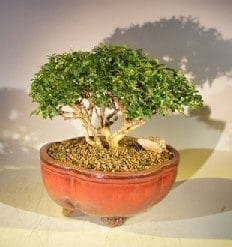
2) Distinguishing boxwood bonsai trees from other bonsais
You will be able to distinguish boxwood bonsai from other bonsai trees because of its versatile trunk and branches which can be transformed into any shape or style. The leaves are small, are found in groups and grow rapidly. It can’t be easily distinguished from other bonsai trees but once it’s pruned and wired the differences in growth is readily seen.
3) Purchasing boxwood bonsai trees
Compared to other trees, the boxwood is always available in most garden shops and bonsai nurseries because it is popular among people who are new to growing bonsai. Therefore you won’t have to look far for that lovely boxwood tree.
But instead of buying boxwood trees, why not look for boxwood in your area or neighborhood? Not only will you save money by buying a tree but you will be able to cultivate a tree that has already acclimated to the environment and climate you are in.
But in case you are buying online, make sure to do research on the retailer or bonsai site that you will be purchasing your tree from. Track your purchase; ask for a tracking number so you will know where around the world is your boxwood tree order.
Shop around. Many online bonsai sites and garden shops sell boxwood trees. Compare the value, prices and shipping rates before you settle on one particular tree.
4) Growing boxwood bonsai trees from seeds and cuttings
Aside from using actual trees, you can grow boxwood from boxwood seeds. However growing your own tree from seeds may take a long time. It can take several years for a boxwood tree to reach a size that is significant for pruning and wiring. But if you got all the time in the world then you might as well boxwood from seeds.
You may either purchase boxwood seeds or you may use seeds from trees that are in your neighborhood.
Growing boxwood bonsai trees from seeds
Before you place seeds in soil to germinate, you must determine which seeds are fertile and while ones are sterile using a simple test known as the glass of water technique. This will tell you which seeds will germinate and which ones will not. This is very important especially when you are buying boxwood tree seeds online.
- Fill a glass or a transparent container with clean water.
- Place the seeds in and wait for the seeds to settle.
- Some seeds will sink while some seeds will float.
- Keep the seeds that have sunk and thrown away those that float.
Seeds that have sunk are seeds that have viable insides which mean these seeds are fertile and are ready to germinate when given the right conditions. Seeds that float are empty because these don’t contain any viable insides. These will not germinate even if these stay in the water for a long time. And now that you know which seeds will germinate and which seeds will not, it’s time to germinate boxwood seeds.
- Fill a small plastic bag with sterile seed starting mix.
- Add a small amount of water to moisten the soil. Make sure that the soil is not wet and there is no standing water inside the plastic bag.
- Place the boxwood seeds inside the soil. The seeds should be buried twice as deep as the longest side of the seed.
- Put only two to three seeds in one plastic container.
- Cover the seeds with the seed planter mix.
- Place the lid on top of the container.
- Place this in the refrigerator for two months.
- Water the soil inside the container when needed. Remove from the refrigerator to moisten it and then return the container promptly.
- Once two months have passed, remove the container from the fridge and place it in a warmer location. The seeds will be ready to sprout at this time.
- As soon as the seeds have sprouted, move the container to a brightly-lit part of your garden.
Once the seeds have opened the taproot will emerge. After a while, small leaves and stems will gradually appear from the seeds. Let these remain in a shady part of your garden. Boxwood tree seedlings can be transplanted to individual containers when these reach about 4 inches in height.
- A small and shallow bonsai pot can be a good starter pot. This should have two holes along its sides and at the bottom of the pot to give your tree adequate drainage.
- Place a layer of coarse substrate or aggregate the pot. This will be the bottom layer before the bonsai soil is added. This will improve aeration and drainage of excess water and fertilizer.
- After the layer of aggregates, add bonsai soil. Use organic potting soil that will hold more water and contain the right nutrients boxwood seedlings need.
- Boxwood trees need moist soils to develop into a mature tree.
- Dig a small hole in the middle of the soil where your seedling will be placed.
- Place your Boxwood tree seedling in the soil. Place another layer of organic bonsai soil and use your fingers to lightly compact the soil.
- Water this regularly and always keep the soil moist. Place this pot in a shaded part of your garden.
Growing boxwood bonsai trees from cuttings
Another way to grow a boxwood tree is to use cuttings. These are stems that are harvested from healthy boxwood trees. These will become young trees. Sometimes cuttings are more preferred by growers instead of seeds because they don’t have to wait for seeds to grow, become seedlings and turn into young trees.
Growing from seeds vs. growing from cuttings
There are a few advantages of using seeds to grow boxwood trees. Trees that grow from seeds have a tap root, the most important first structure of all plants. This is a thick root that first comes out from the seed. This is important in the growth of young plants because this stabilizes the plant and helps absorb nutrients from the soil better.
Cuttings don’t have taproots and therefore may not be as stable as trees grown from seeds. On the other hand, this is overcome by allowing the cutting to grow complex root systems before these are planted in their individual pots. Here is how to harvest cuttings from boxwood trees.
- Choose healthy boxwood bonsai tree where you will harvest cuttings from.
- This tree should be in perfect health and grows new leaves and stems on a regular basis. This tree should be free from pests or diseases.
- Harvest cuttings from the boxwood bonsai trees. The stem should be healthy with no issues.
- Use a clean or sterile cutter or scissors to harvest the cutting.
- Harvest by using a diagonal cut.
- Place the cutting in water afterward to prevent air pockets from entering the stems.
- Leave the cuttings to develop roots. You can let these remain in water or you can already plant this in bonsai soil.
- When the roots have thickened and the cutting is now stronger and starting to grow new leave and stems, this is ready to be placed in soil, in individual pots.
- After transplanting in individual pots with bonsai soil, water the cuttings daily and keep the soil moist. Keep in mind to water only when the soil is dry and not when the soil is moist to prevent root rot and the development of molds.
5) Caring for a boxwood bonsai tree

Boxwood bonsai trees grow fast and may need to be pruned every now and then to create different styles. But despite growing very quickly, the leaves and stems do not thicken fast. Some bonsai enthusiasts may use older trees to start their bonsai. Boxwood hedges, on the other hand, offer good material to be used as bonsai trees. Cuttings should be collected during March and April to get the best results.
Since there are many species of boxwood, you must learn about the species of boxwood you want to grow before you indulge in growing boxwood trees. Although the ways to care for different boxwood species are generally the same, there are still some important things that you must take note of.
Practice makes perfect. If you have boxwood hedges in your backyard, use these as practice bonsais before you indulge in actual bonsai making.
For the best results, bonsai enthusiasts should place Boxwood bonsai trees in partial sunlight. In nature, Boxwood naturally grows underneath larger trees and can handle this amount of light better. Unfortunately, this bonsai tree can only tolerate up to -4°C. If temperatures go below this, the plant should be offered extra protection or brought inside. Slight frosts may also cause the leaves to yellow, but they will brighten again once springtime comes around.
If the Boxwood sustains any wounds, it will generally heal well. Older plants or parts of the plants may have more difficulties healing after it receives a large wound. Generally, older parts of the tree should just be left as a deadwood feature instead of being cut off or modified.
Over time, the Boxwood bonsai tree will have to be repotted. Under normal circumstances, owners can expect to have to repot their plant their plants every other year. If the bonsai is repotted more often, it will grow more vigorously.
6) Soil and re-potting a boxwood bonsai tree
The ideal soil for re-potting boxwood bonsai tree is a soil that can absorb water and fertilizer and can remove excess water and fertilizer as well. It has to be sandy loamy soil; soil that also has good aerating properties. Boxwood bonsai needs a lot of water during its developmental or growing phase. This type of soil will make sure that water is absorbed well, the soil is moist but not soggy.
When it comes to the ideal pots for re-potting, the best one has to be a pot that has adequate drainage. This will allow excess water and fertilizer to drain out of the soil. There are lots of different pots to choose from when you visit a bonsai center or garden center. Most bonsai enthusiasts prefer to stay true to Japanese tradition and use jade pots for their boxwood bonsai trees. But no matter what type of pot you use, never forget to choose pots with good drainage.
Boxwood trees should not be re-potted any sooner than two and three years. If this tree is repotted sooner, it will grow very rapidly.
7) Watering a boxwood bonsai tree
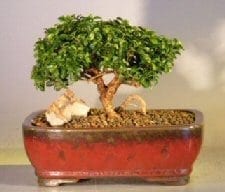
Water the boxwood bonsai tree as needed and increase watering when the weather is warm. Keep the soil moist but not soggy. Reduce your watering during the colder months (during fall and winter time).
Water your bonsai with good clean water. If you are in doubt about the health of your water supply have this tested before you use this on your plants.
8) Growing boxwood bonsai trees
Boxwood bonsai trees should be grown in partial sunlight. These trees naturally grow under large trees and therefore can handle this amount of light better than full sunlight. Boxwood bonsai can only tolerate up to -4 degrees Centigrade. If the temperature goes below this, the plant should be given extra protection or should be placed indoors. Slight frosts may cause the leaves to go yellow. These will turn green again once springtime comes round.
When the tree develops wounds or gets injured, it will be able to heal well. Other plants often partially heal injuries leaving ugly marks on branches and trunks. Older parts of a boxwood tree should be left as a deadwood rather than cutting it off.
9) Pruning and shaping a boxwood bonsai tree
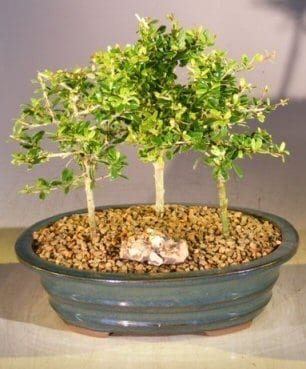
Most boxwood bonsai trees grow very rapidly and gardeners usually need to thin and prune the inner branches of the tree to maintain its shape. Create a pruning schedule to promote back-budding and improve ramification. This will also keep the branches from losing leaves.
Some growths should be left on the tree and even encouraged. Allow the plant to grow as it would like during early spring. Start to prune or pinch to refine it after it has grown on its own.
Some boxwood trees will respond well to partial defoliation.
After new growths start to extend, you can wire the tree to train it. Wiring has to be done before the buds start to harden and during the time when the branches are still pliable. Older shoots and branches are very difficult to wire so never forget to wire when the tree is still young. Instead of wrapping the wire around the branch you want to train, you can use air-wiring to move branches and keep the shape of the tree.
The type of wire to use for wiring
There are two kinds of wires to use on bonsai trees. You may use anodized aluminum or annealed copper wires. Anodized aluminum wires are for deciduous trees that have harder and stronger trunks and also for young trees. Annealed copper wires are for trees that have harder trunks like conifers and pine. You will also find wires in a variety of thicknesses and the most commonly used ones for wiring bonsai are the 1 mm to 4 mm wires.
If you are growing and wiring bonsai for the first time you must use anodized aluminum wires because these are easier to handle. This type of wire is available from any local hardware store. Although using wires is a good way to train bonsai trees, these may cause injury to bonsai branches such as the branches of young bonsai trees. You must always be careful when applying it to your bonsai tree.
Preventing injuries can be done by using raffia. This is a material that is wrapped around the branch you want to wire to protect it. Raffia is palm fiber that you can get from garden stores. It is soaked in water and wrapped around the tips of the branch or bark. This will serve as protection from damage because of wiring and bending.
Step by step instructions on how to wire a bonsai
- Choose the type of wire that you will use for the activity. Choose the gauge of wire that you will use as well.
- Measure the length of wire and cut with a sharp pair of pliers.
- Take one end of the wire and start wrapping it securely on the branch you want to wire. Wrap the wire at a 45-degree angle.
- Wrap the wire in the extent of the branch, do this neatly.
- After you are done cut the excess with the use of pliers.
- Gently bend the branch to the position that you want.
- If you have branches that are too high you can use a guy wire. Wrap moist raffia around the branch and place a hook at the end. Tie a wire on the hook and secure it to a strong root. This will bring down high branches easily.
- If you want to raise a branch that is too low, take the end of this branch and wrap raffia around it. Add the hook and place a guy wire on the hook. Attach the end of the wire to anything that is above the bonsai.
- Remove the wires during the same season it was applied.
- After wiring, take note of the growth of your boxwood bonsai tree. Put the pot in a shaded area of your garden and not in direct sunlight. Water this pot daily. Place balanced fertilizer in the pot so that it can recover.
Important wiring techniques
Wiring is the key to achieve different designs and styles for boxwood bonsai trees. Wiring will reposition bonsai branches safely and effectively. There are a number of bonsai styles that you can use on a boxwood bonsai tree.
Boxwood bonsai trees are best styled as informal upright. Some people will try other forms of training the plant, but this one generally works the best. To start these trees out, propagate them in late spring or summer.
Overall, Boxwood is a very hardy plant. It can be prone to red spider mites, so keep an eye out for it during the summer months. Another thing to be careful about is Box Blight. This fungal disease can cause the leaves to develop spots or fall off. Bark might develop black streaks and the grey fungus may be visible on any leaves that are remaining. Unfortunately, this fungus has no cure and the plant will normally die within three months. If this is spotted on any Boxwood bonsai trees, the affected plants should be separated from healthy Boxwood.
Boasting of over 70 different species, Boxwood is found throughout Europe, Africa, Asia and Central America. These compact plants are well-suited for bonsai and respond very well to training. Since it is a popular plant for landscapes, regular Boxwood plants can be found at any nursery and can easily be trained into being a bonsai tree.
Shakan Bonsai Style
The Shakan bonsai style is possibly one of the best styles that will bring out the beauty of a boxwood bonsai tree. This is a slanted bonsai tree style that depicts the appearance of a slanted tree in nature.
The trunk of the bonsai emerges from the soil in a slanted position. The rest of the tree grows in an outward way. The trunk is in a 60-80 degree angle that creates a natural slanted position. This style is achieved by strong wiring to train the main trunk and position it in a slanted manner. Wiring will not just position the trunk in a slanted way but it can control the height of the branch. Using strong lighting from one direction and tilting the pot may also tilt the trunk to create that windswept style.
Shari Bonsai Style
The Shari Bonsai Style is shaving the bark of the tree to prevent any new growth from sprouting. This style is also known as the stair effect and the branches may be long or short in this style. The overall design is achieved by using wiring and pruning techniques. Leaves at the top of the tree create a balanced appearance which completes the style. The Shari bonsai style is all about the natural development of trees and plants in nature. You will also find a barkless area along the trunk to depict the effect of harsh weather conditions on trees to trees.
Seki-joju or Rocky Terrain
The Seki-joju or Rocky Terrain style is a design that proudly presents the aerial roots. It is all about growing bonsai roots cleverly through natural obstacles. Obstacles in nature could be anything like a jagged or smooth rock. In nature, this happens when the roots of trees grow underneath and along the sides of rocks. Naturally, the roots of trees are very adaptable because roots will simply move around any obstruction. The trunk of the bonsai has grown regularly. The rest of the tree will grow in a straight way no matter what obstacle is found along its path. The Rocky Terrain bonsai style is used in bonsai presentations in trees that have healthy and well-presented aerial roots.
Literati Bonsai
The Literati style is a bonsai style that will work perfectly for boxwood bonsai trees. This design has a classic skinny trunk and curved leaves. The boxwood bonsai tree will have a lovely canopy of leaves when this is pruned and wired accordingly. Bonsai enthusiasts say that this style is all about the struggle for even the smallest life form to exist in nature. In the literati style, a few bald spots along the trunk is seen and this will look like dead branches. This bonsai style is found in nature when trees grow in densely populated areas like forests and woodland areas.
Dramatic Fukinagashi
The Dramatic Fukinagashi style depicts the look of a person with the windswept head of hair in a storm or high wind. A boxwood bonsai tree will fit this extra-ordinary style only when this is styled and trained. In the Fukinagashi style, the branches and the trunk grow on one side. You need wires to position the trunk and minimal pruning to develop that windswept look.
Han-kengai
The Han-kengai bonsai style is a cascading effect. The section of the trunk protrudes in a straight manner as a branch grows outward and slightly downward. A portion of the trunk is found along the section where the thick branches are located. The branches will grow in different directions and grow low-lying leaves and stems. This bonsai style must be placed in a deep pot to preserve the elegant cascading design.
When to start wiring
You must start wiring a boxwood bonsai tree as soon as it is strong. Wiring may be done any time of the year. Apply wires on boxwood trees during the growing season or as the branches become thicker so you can style this according to the design you want.
Remember to remove the wire when it is due and in the case of boxwood bonsai trees, on the same season it was wired. Overlooking this can badly injure a boxwood tree. And as your tree is wired don’t forget to check on your tree regularly. It should be growing new leaves and stems on a regular basis, should be drinking well and responding to fertilizer feedings. Remove the wires by cutting it piece by piece. This will help you remove the wire easier and faster and avoid injuring your tree.
Post-wiring care for your Boxwood bonsai tree
After wiring a boxwood tree bonsai place this in a shaded area of your garden. Place it in a shaded area of your garden or backyard because it has to regain its health and strength. Placing the tree under direct sunlight will only dry the soil and this could be very detrimental to boxwood bonsai trees. Provide balanced fertilizer to help your tree regain its health and strength.
Remove the wires on the date it is supposed to be removed. Prevent damage to the bark and branches. Cut the wire at every turn and never attempt to remove it completely. Never reuse the wire for wiring other branches because this is spent. This will also prevent diseases and molds that may be passed from one tree to another.
Monitor tree health closely after wiring and let your bonsai tree rest before you start pruning and wiring it again. If possible keep a growing diary or photo album of your pruning and wiring activities. With these, you will be able to monitor your bonsai tree’s shape and appearance season after season.
10) How to prevent pests and diseases

Boxwood bonsai trees are known to be hardy and fast growers but it is just like other bonsai trees because it is prone to certain conditions that may plaque bonsai plants. Boxwood may be prone to overwatering and which can lead to leaf discoloration, root rot and mold growth. So dry the soil completely before watering this tree. Never water when the soil is moist but only when the soil is high and dry.
Yellowing of the leaves is irreparable. The only solution is to dry up the soil by using the right kind of planter or pot, the ideal soil that will drain water away from the roots.
Another common problem for boxwood is pests. Pests like caterpillars and mites have a voracious appetite and could eat up your bonsai’s leaves in no time.
Use natural and organic pesticides to help you deal with pests. You must also do all you can to watch out for pests in your plants. Never leave any leaf or any stone unturned when you are checking for pests. Remember that when you see one pest or bug there may be more left nearby.
Conclusion
The boxwood bonsai tree is a kind of ornamental tree that grows quickly and steadily. It is a popular ornamental plant that can be shaped according to a style you want to follow. There are hundreds of boxwood bonsai and learning about the type of boxwood you want to grow is very important. And when it comes to pruning and wiring, this tree is among the best to start with because of its ability to grow more leaves but not to the point of affecting the overall style of the plant.
There are more bonsai trees to come but nothing can replace the boxwood’s gentle and thriving characteristics. By following these strategies on how to grow and style bonsai trees, you will become more skilled and very confident in caring for boxwood bonsai trees. This could be a good starter bonsai to use when you are just learning how to deal with bonsai-growing.
